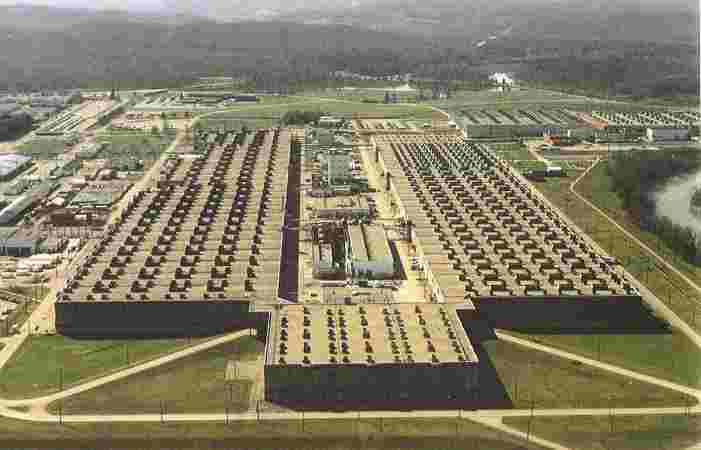|
The K-25 Plant, authorized in late 1942 with site preparation beginning in June 1943, was built to separate uranium 235 by a more economical method than either the Electromagnetic Separation of Y-12 or the Thermal Diffusion of S-50. This plant was one of the largest scale-ups of laboratory equipment in history and involved process systems of unprecedented vacuum tightness and unusual cleanliness. The original plant was expanded to cover more than 1500 acres and was the forerunner of similar facilities in Paducah, Kentucky, and Portsmouth, Ohio. These plants were a source of enriched uranium which was used to fuel both military and civilian nuclear power reactors. Only the Paducah, Kentucky plant remains in full operation in 2004. An even more efficient technology, Gas Centrifuge, is now being developed for future uranium enrichment operations. In September 1943 work began at the K-25 site on the cascade building, plans for which had changed dramatically since the spring. Now there were to be fifty-four four-story buildings in a U-shape measuring a half-mile long by 1,000 feet wide. Covering some 44 acres, the K-25 building was the world's larges roofed structure when it was completed in March 1945. Innovative foundation techniques were required to avoid setting thousands of concrete piers to support load-bearing walls. Once the K-25 gaseous diffusion process was fully operational in March, 1945, it began feeding the Y-12 Electromagnetic Separation Process with enriched uranium thus increasing the total output of Y-12 sufficient to allow the needed quantity of U-235 for Los Alamos to fabricate the world's first atomic bomb. After World War II ended and the Cold War began, K-25 continued to provide the U-235 required for nuclear weapons, nuclear reactors and nuclear submarines until it was closed in 1985, never having been shutdown because of operational problems. This feat accomplished with an unproven technology and the most complicated high level vacuum system in the world at the time of its creation. Preserving the North End Building will compliment the American Museum of Science and Energy by providing an interpretive center focused on the three methods pursued at Oak Ridge to produce enriched uranium for the world's first atomic bomb as well as the scientific and technological developments that have emerged from this work over the past 60 plus years. |

|
| Return to K-25 Main Page Next Phase Artist Rendition Proposal Article - Cindy Kelly |